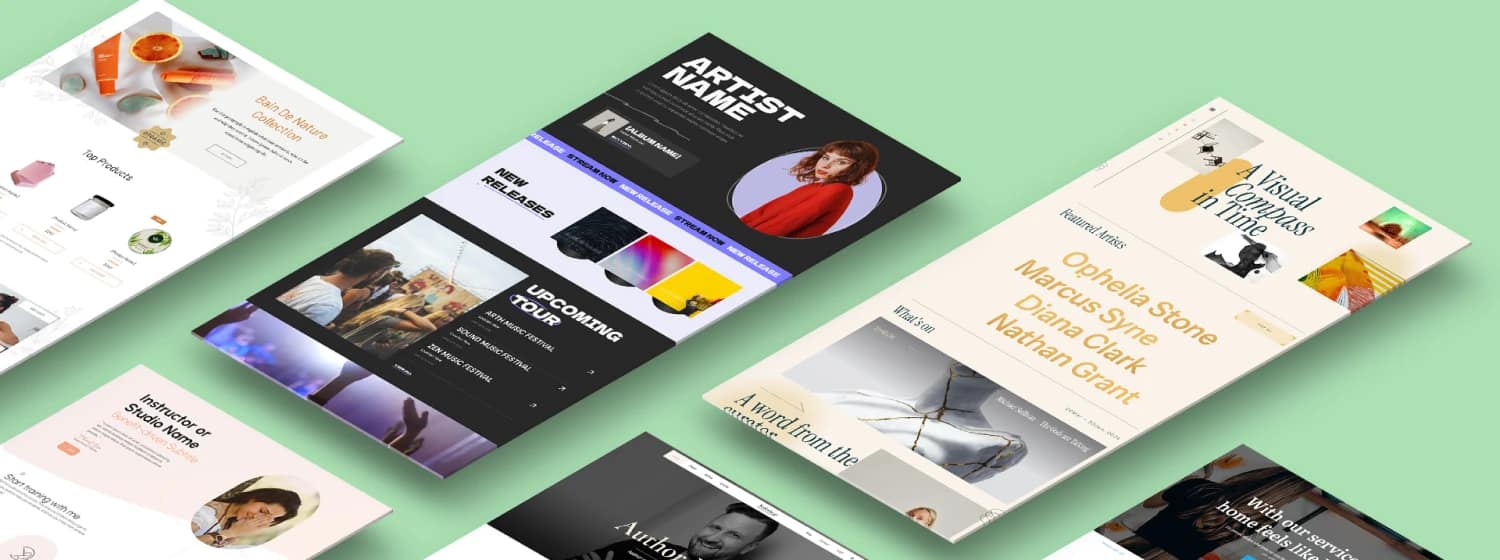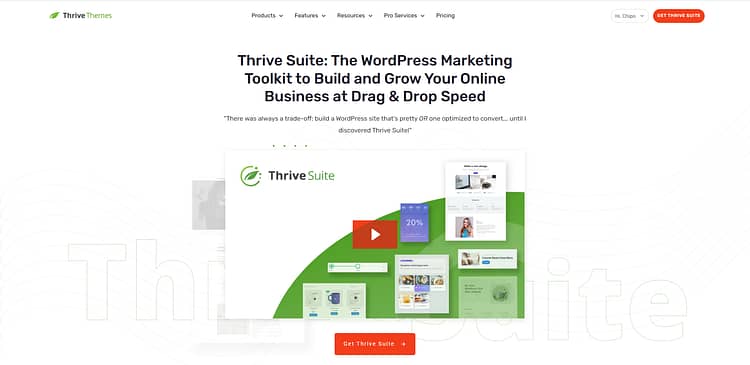As a creative (and someone who’s definitely said “my work will speak for itself” more than once), I know how you may be feeling. You didn’t become an artist to worry about conversions or web design.
But the thing is… if your artist homepage isn’t turning visitors into subscribers, buyers, or even semi-curious fans… it’s really holding you back.
And you’re not alone. The average art website conversion rate hovers around 4.6%, but some online artists have shared that this could be even lower:
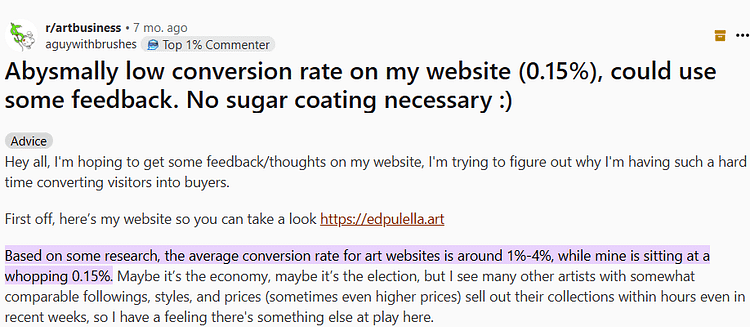
…some as low as 0.15%. That’s almost everyone clicking away without taking any meaningful action.
The problem with most online art portfolios is that they look good but don’t do much. No clear direction. No opt-ins. No gentle nudge to say, “Hey, stay a while.” Just a quiet scroll and a silent bounce.
But in this algorithm-driven, attention-span-shrinking digital world, your website needs to do more than just sit there and look good. It needs to work for you.
Your Homepage Should:
- Reflect your creative voice
- Support your business goals
- Grow your audience — on autopilot
And that’s what this guide is for.
To show you how to build a homepage that actually works — using the right tools built for creators who want results without needing to code a single line.
Here’s the Solution: A Strategic, Conversion-Focused Homepage (And Exactly How to Build It)
Here’s what you need:
A clean, high-performing artist homepage that turns strangers into buyers, clients, or subscribers — without wasting your time or draining your creativity.
This means building a portfolio website that is visually appealing and helps you:
A Portfolio Website Helps You:
- Sell art online
- Grow your email list
- Book commissions or showings
- Build trust and visibility with collectors

And you need to do it fast — without coding, without second-guessing every layout decision, and without relying on an expensive developer.
That’s exactly what this section gives you.
We’re going to walk through the entire process step by step, using Thrive Suite — a tool built to help creators like you design, launch, and grow conversion-driven websites.
Ready? Let’s build the homepage your art (and your future self) will thank you for.
Why I Recommend Thrive Suite for Your Artist Homepage
If you're serious about turning your website into a tool that actually supports your creative career, Thrive Suite is what I recommend — and use.
It’s an all-in-one toolkit that gives you full creative control without the headaches of struggling to stitch plugins together or learning how to code at midnight.
You get:
Thrive Architect – a visual builder that lets you design with precision and style
Thrive Theme Builder – so your entire site feels cohesive and on-brand
Thrive Leads – to grow your email list with beautiful, targeted signup forms
And here’s something you’ll appreciate as an artist: we actually have a theme designed specifically to showcase visual work beautifully: Gallery.

Clean layouts, bold galleries, and thoughtful spacing — all with performance built in. But if that one’s not your style? No stress. Every Thrive theme is flexible enough to support a portfolio-focused layout with just a few tweaks.
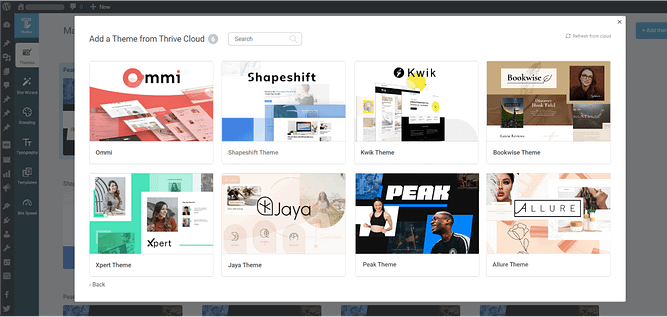
So you don’t just get one “right” option — you get choice. And it’s all conversion-focused under the hood, so your homepage doesn’t just sit there looking pretty — it works.
Step-by-Step — How to Build Your Artist Homepage with Thrive
So now that you’ve got the right tool, let’s make it work for you.
Building a high-converting artist homepage isn’t about cramming in every widget or chasing the latest design trend. It’s about clarity, structure, and guiding your visitor toward one clear goal — whether that’s selling your art online, booking custom commissions, or growing your email list.
Here’s exactly how to do it using Thrive Suite, step by step:
Step 1: Define Your Homepage’s Primary Goal
Before you touch a single layout block, you need to be crystal clear on what your artist homepage is actually for.
Do you want people to:
Your Homepage Goal:
- Buy your artwork directly?
- Commission a piece based on their preferences?
- Subscribe to your artist newsletter for updates and launches?
- Send inquiries about collaborations, licensing, or exhibitions?
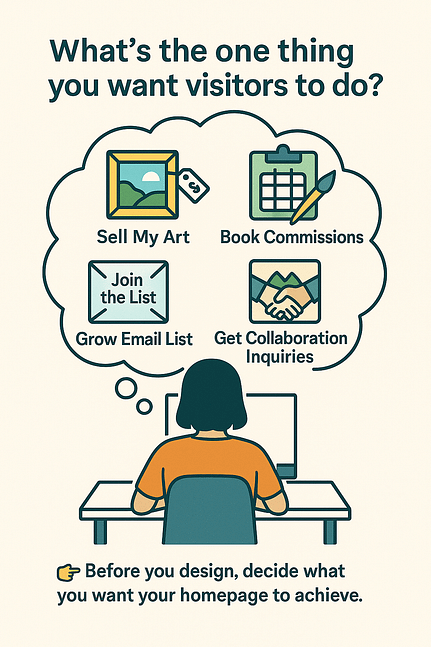
Everything — from your website layout to your call to action to the way you write your headline and intro copy— should revolve around that one main goal.
Otherwise, your homepage becomes a quiet scroll with no action at the end.
Chipo's Pro Tip
You can still link to your online gallery, artist portfolio, or shop page — but your primary CTA should be unmissable. Think of it like guiding someone through your studio: don’t just open the door, show them where to go.
Step 2: Structure Your Homepage Using Thrive Architect
Now that you’ve nailed your goal, it’s time to bring real structure to your artist homepage design — and this is where Thrive Architect, our drag-and-drop WordPress page builder, makes life a lot easier.
Think of your homepage like a visual storytelling journey. Each section should naturally lead to the next, building interest and trust without overwhelming your visitor.
A proven homepage layout flow looks like this:
Hero section – A bold headline, one strong image, and a clear CTA

Portfolio preview – A snapshot of your featured art pieces (we’ll cover this in Step 3)
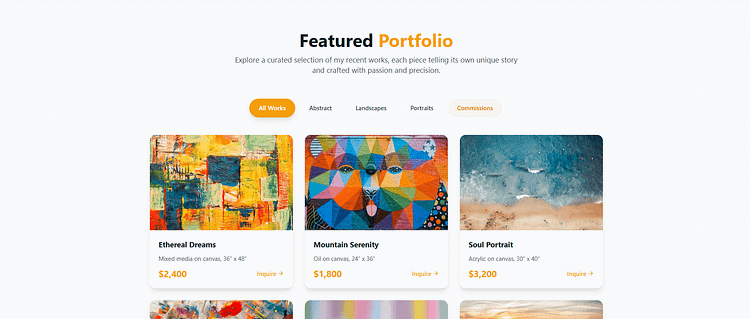
About section – A short intro to who you are and what you do

Call to action block – Make it stupid easy for them to reach out

🧩 With Thrive Architect, you can drag in ready-made layout blocks, use section dividers, and even add subtle animations or scroll effects to guide the eye — all while keeping the look clean, responsive, and mobile-friendly.
💡 Don’t worry about being flashy. Focus on being clear, strategic, and goal-driven.
Step 3: Curate and Present Your Portfolio
This is the heart of your homepage for artists — but it’s not a dumping ground for every piece you’ve ever made.
You want your portfolio section to showcase your best work and inspire action, not decision fatigue.
Here’s how to make it work:
How to Curate Your Portfolio:
- Select 10–25 strong pieces that reflect your current style
(If you’re still building, 6–10 works is great — quality over quantity) - Use a consistent gallery layout — grid or lightbox design keeps things organized
- Add art metadata — title, medium, size, year, and if applicable, price or availability tags
- Include direct portfolio CTAs — e.g., “Buy this print,” “See full collection,” “Commission a similar piece”
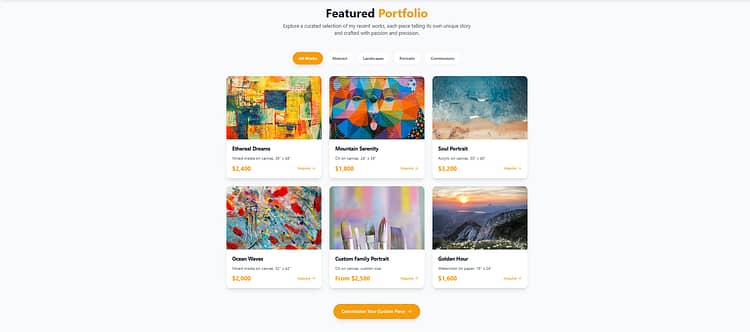
🖼️ With Thrive Architect, you can easily drop in a customizable image gallery, play with hover effects, and group works into themed collections if you’d like. You can even use pre-designed content blocks to speed things up and keep your brand consistent.

Let your work shine — but make sure it moves people somewhere too.
Chipo's Insight
Think of your portfolio on the homepage as a curated gallery exhibition, not a storage locker. Each piece should serve a purpose and contribute to your overall artistic narrative.
Step 4: Write a Short, Strategic About Section
This is where a lot of artists go off track — writing a full life story when all your visitor really needs is a reason to trust your credibility and feel a personal connection.

Your About section isn’t a memoir. It’s a quick, intentional artist elevator pitch.
What to Include in Your About Section:
- A short third-person bio – 3–5 sentences max. Keep it professional and reader-focused
- Key highlights – Art education, notable exhibitions, awards, or published features
- One strong photo – A studio shot or warm artist portrait helps build connection and trust
🎨 Keep it concise and let your personality peek through — just enough to make someone want to learn more after they’ve taken action. If you want to add more details about yourself, create a full about page specifically for that purpose.
And remember: if your homepage goal is to grow your email list or sell artwork online, don’t bury the CTA under a wall of text.
Step 5: Make Contact Frictionless
Here’s the thing: if someone’s interested in your art, don’t make them hunt around for how to reach you.
Your artist homepage should make contacting you feel easy, natural, and low-pressure — whether they want to buy a piece, commission custom artwork, or simply ask a question.
Here’s how to do it:
Make Contact Easy:
- Add a visible call-to-action section — e.g., “Book a commission,” “Inquire about availability,” or “Let’s work together”
- Use a styled contact form with only a few fields (Thrive Architect makes this effortless)
- Offer a direct email address as a backup — some collectors prefer it
- Add social media links only if they support your goal (don’t send people away unless they’re ready)
- Optional: Use a Thrive Leads form to collect emails right here too — especially for waitlists or exclusive drops

📬 Make it feel like sending a message to a real person, not submitting a job application.
Step 6: Design for Flow, Not Flash
This is where many artists get tempted to over-design — animated galleries, parallax backgrounds, spinning cursors... it’s a lot.
But great design doesn’t shout. It guides.
Your artist homepage should breathe. It should lead someone through your work without overwhelming or confusing them.
Here’s how to strike that balance:
Design for Flow:
- Use whitespace generously – It helps your work stand out and gives your site a modern feel
- Keep typography simple and readable – No need for cursive fonts or wild headers (learn more about correctly using your fonts here)
- Stick to 1–2 accent colors – Let your art be the color, not the background noise
- Use scroll animations sparingly – Thrive Architect lets you add motion, but make it purposeful
🖥️ The goal? A portfolio website that feels intentional, elegant, and easy to explore — not like it’s trying too hard.

Step 7: Optimize for Mobile and Speed
Your artist homepage might look stunning on desktop — but if it’s slow or clunky on mobile, most visitors won’t stick around.
Today’s art collectors and fans often discover you on their phones. If your portfolio website doesn’t load fast or display cleanly, you’re losing leads before your work even has a chance to connect.
Here’s how to make your art website fast and responsive:
Optimize for Mobile and Speed:
- ✅ Use Thrive Architect’s mobile editor to fine-tune layout, fonts, and spacing for smaller screens
- 📸 Compress your images — large files = slow load times (learn more about image optimization here)
- ⚡ Keep your homepage clean and focused — minimal sections improve speed and user flow
- 🔍 Test on multiple devices — check iOS, Android, tablets, and small screens
- 📈 Google rewards mobile-optimized sites, helping your work show up in more searches
Your art deserves to be seen. Don’t let a slow, unresponsive site get in the way.
And if you need more guidance on website site speed optimization, this is the perfect guide for you.
Chipo's Story
I once had a beautiful website that was incredibly slow on mobile. I quickly realized I was losing so many potential connections because people just wouldn't wait. Optimizing for speed and mobile wasn't just a technical fix, it was a game-changer for reaching a wider audience.
Why Most Artist Homepages Fail
I know this might feel like a lot and not what you signed up for. You’re an artist, you just want to create, inspire, and occasionally panic about deadlines—not to wrestle with confusing website templates at 2 a.m.
But you have to realize this: even amazing art can't overcome a weak homepage. Unfortunately, most artist homepages quietly struggle for reasons that are super common, and thankfully easy to fix once you know what to look out for.
Some of the main reasons are:
Common Reasons Artist Homepages Fail:
- 🎨 All Looks, No Strategy
That minimalist art website template might look sleek, but if it’s not guiding visitors to act, it's just aesthetic and flat. A smart art gallery website is built to showcase artwork and convert — whether that’s to sell art online, book a commission, or grow your email list. - 🚫 No Clear CTA (a.k.a. “Now What?” Syndrome)
If your homepage doesn’t say “buy this print,” “commission art online,” or “join the list,” most visitors won’t do anything. Great art homepage examples lead people somewhere — clearly, directly, and with purpose. - 🖼️ Too Much (or Too Little) Art
A strong online art portfolio doesn’t mean uploading everything you’ve ever made. On the flip side, if your homepage is nearly empty, it creates doubt. Aim for 10–25 standout pieces that reflect your style and help sell your artwork without overwhelm. - 📄 Outdated Bios & Confusing Navigation
Your art bio page and artist CV are important trust-builders. But if they haven’t been updated in years — or are hard to find — visitors may think you’ve disappeared. Keep it simple, current, and easy to navigate. - 📱 Not Mobile-Friendly
Your homepage might look great on desktop, but a clunky experience on mobile is a deal-breaker. A mobile-friendly artist site is essential now — most collectors, curators, and buyers will discover your work on their phones. - 📪 Hidden or Hard-to-Find Contact Info
If people want to reach you and can’t? That’s a missed opportunity. Your artist website should make it ridiculously easy to get in touch — not feel like a digital maze. - 📉 No Email Opt-In = No Long-Term Growth
Without a clear opt-in form, you’re missing out on building a list of interested collectors, fans, or curators. When you use one of the best website builders for artists (Thrive Suite) that should help you capture that interest and stay connected.
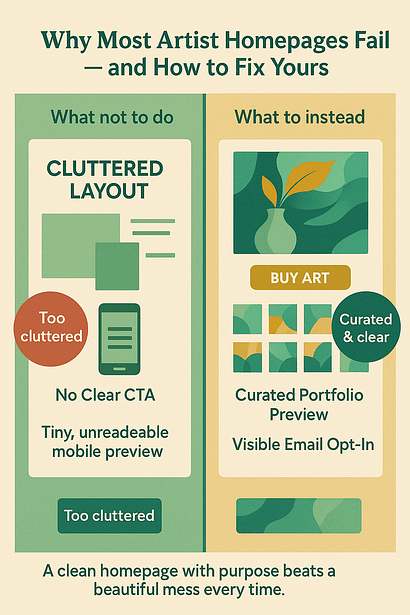
Bottom line: a few strategic tweaks can turn your homepage from pretty-and-passive to effective-and-profitable—and I'm here to help you make it happen.
And It Gets Worse When You Don’t Know What to Fix
Here's the toughest part:
When your homepage isn't working, it's not always clear what exactly is going wrong. So instead of blaming the website, you start questioning your own work (cue existential crisis).
You watch visitors land, scroll politely through your art, and then... vanish.
Ghosted by strangers on the internet. Ouch.
At this point, it's easy to convince yourself: "Maybe the internet just doesn’t work for artists."
But trust me—that couldn't be further from the truth.
The real cost here isn't just frustration or bruised pride. It’s the missed opportunities:
Missed Opportunities of a Weak Homepage:
- Exhibition invites that never hit your inbox.
- Commission requests you never even hear about.
- Collaborations and partnerships slipping through your fingers without you knowing.
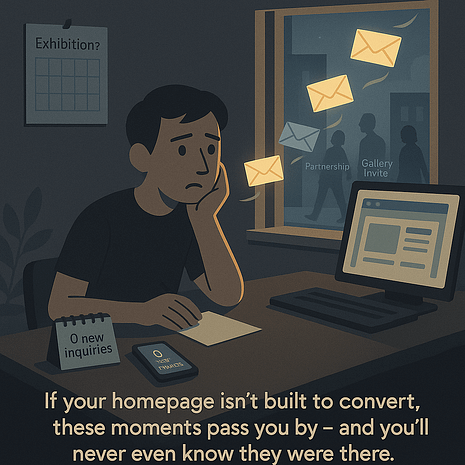
And here's the trap that nearly every artist (myself included!) has fallen into at least once:
You rebuild your website over and over, chasing shiny templates, trendy platforms, or complicated plugins—hoping each new thing will fix the problem.
But the real issue isn't your talent, your audience, or even your tools. It's simply a homepage that isn't built to convert.
Luckily, now you know exactly what needs fixing (and how easy it can be). Let's stop spinning in circles and get your homepage working—for real this time.
Creative Features That Set You Apart
You’ve already nailed the basics: your artist homepage looks sharp, your online art portfolio is curated, and your contact info’s right where it should be. But if you want people to remember you — not just scroll past — you’ll need more than the usual.
These aren’t gimmicks. They’re creative, strategic touches that make your site feel personal, professional, and built by someone who knows what they’re doing. Think of them as the difference between just having a website… and having one that actually sells art online, books commissions, and builds trust.
Ready to level up your art gallery website? Let’s add a little spark.
Idea 1: Interactive “Choose Your Path” Homepage
Not every visitor comes to your site for the same reason — and that’s exactly why a one-size-fits-all homepage can leave people confused, or worse, uninterested.
An interactive “Choose Your Path” section lets visitors self-select their journey the moment they land. You could offer buttons or cards like:
Choose Your Path Options:
- 🛍️ I want to buy your work
- 🎨 I’m interested in a commission
- 💌 I just want to follow your updates
This small change does something powerful: it segments your traffic without any tech headache — so you’re sending the right people to the right pages.
Set it up with Thrive Architect for the layout and use Thrive Leads to display targeted opt-ins for each path. Clean, clear, and strategic.
It’s not just good UX — it’s conversion magic.
---
Idea 2: Scroll-Based “Behind the Canvas” Story
Most homepages just show the final product. But your process? That’s what builds intrigue.
A scroll-based “Behind the Canvas” section turns your homepage into a storytelling experience. Think of it like an interactive art documentary — short, visual, and full of personality.
Here’s what it might include:
Behind the Canvas Elements:
- A time-lapse video or progress photos
- Quotes from your journal or inspiration notes
- A few personal reflections or design choices
- A final reveal of the piece
- And a strong CTA: View the full collection or Buy this piece
You can easily build this with Thrive Architect, using stacked sections, smooth scroll animations, and video blocks.
The result? A homepage that feels like your work — and invites people to stick around, explore, and connect with your voice.
---
Idea 3: Commission Estimator or Booking Quiz
Let’s be real: some visitors want to work with you — but they’re not sure how it works, how much it costs, or if they can afford it.
Enter: a Commission Estimator Quiz.
This quick, friendly tool can ask simple questions like:
Commission Quiz Questions:
- What size are you looking for?
- What medium do you prefer?
- What’s your timeline?
Based on their answers, you can show a rough price range, studio availability, or next steps.
Gate the results behind an email opt-in using Thrive Quiz Builder + Thrive Leads, and you’ve just turned curiosity into a qualified lead.
It feels helpful to the visitor — and positions you as a serious, in-demand professional. And you can learn how to build this kind of product recommendation quiz right here.
Chipo's Insight
This is a great way to filter serious inquiries from casual browsers, saving you time and ensuring you're connecting with genuinely interested clients.
Track and Improve What Works
Once your homepage is live, your job isn’t over — it’s just beginning.
You need to know what’s working, what’s being ignored, and where people are actually engaging.
Here’s what to keep an eye on:
What to Track:
- Which CTAs get clicked the most
- Which artwork gets the most views
- Which opt-in forms are converting
Use MonsterInsights to easily connect your site to Google Analytics — no coding required. You’ll get clean, actionable reports right in your WordPress dashboard.
Want to test different layouts, colors, or headlines? Use Thrive Optimize for quick A/B testing without the tech overwhelm.
This isn’t about obsessing over numbers — it’s about letting real data guide your next smart move.
Artist Homepage FAQs
Your homepage isn’t just a gallery — it’s your handshake, elevator pitch, and call to action rolled into one.
At minimum, it should include:
- A striking hero image (or two) that captures your style
- A clear headline and CTA: Shop now, View my work, Book a commission
- A curated portfolio section
- A short, engaging “About” blurb
- Contact info (not buried!)
- An email opt-in or way to follow your journey
If someone lands on your artist homepage, they should know who you are, what you do, and what to do next — in under 10 seconds.
If you’re selling or taking commissions, 100% yes.
An FAQ page (or section) answers questions before someone even hits “send,” which:
- Builds trust with new visitors
- Reduces back-and-forth emails
- Positions you as a professional
- Boosts your site’s SEO with helpful, search-friendly content
Even just 3–5 well-written questions on pricing, process, or delivery can help someone go from just Browse to ready to buy.
Enough to impress — not overwhelm.
Aim for a tight selection of 10 to 25 pieces. Think of it like a personal highlight reel. You want to show range and skill, but you don’t need to show everything you’ve ever made.
A clean, intentional layout helps visitors explore without feeling lost — and gives your strongest work the attention it deserves.
If you sell artwork directly: yes. Be upfront.
If you do custom work: a “Starting at…” range or a commission FAQ works well. Bonus points if you add a simple quote request form or booking quiz.
The truth? People hesitate when they have to guess. Clear pricing = less friction, more trust, and more action.
Chipo's Story
I once struggled with displaying my prices, fearing it would deter potential buyers. But what I found was the opposite: transparency builds trust and attracts genuinely interested clients who are ready to invest in art. Don't hide your value!
Conclusion — Build the Homepage Your Art Deserves
Your work deserves more than a homepage that just looks good.
It deserves a site that speaks for you, guides your visitors, and actually helps you grow — whether that means selling, booking, or building a loyal following.
You’ve already done the hard part: creating powerful, meaningful art. Now it’s time to build a homepage that supports it with the same level of intention.
With the right tools and strategy, your website becomes more than a portfolio — it becomes your most powerful creative asset.
🎯 Ready to build a homepage that works just as hard as you do?
👉 Explore Thrive Suite — and create a site that turns admiration into action.

